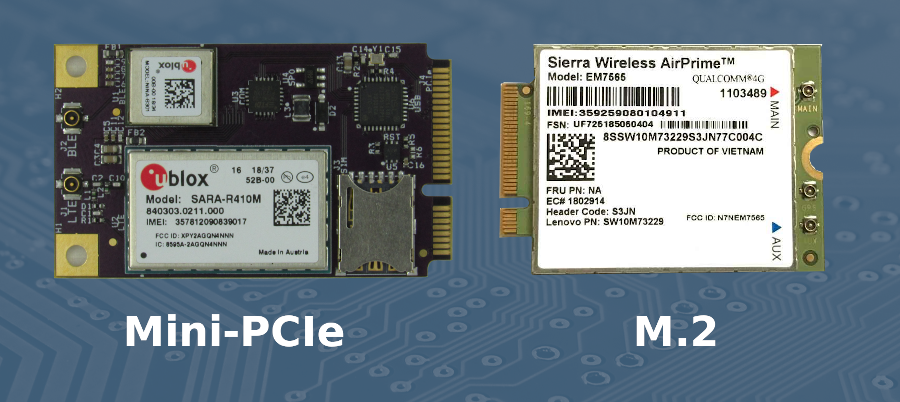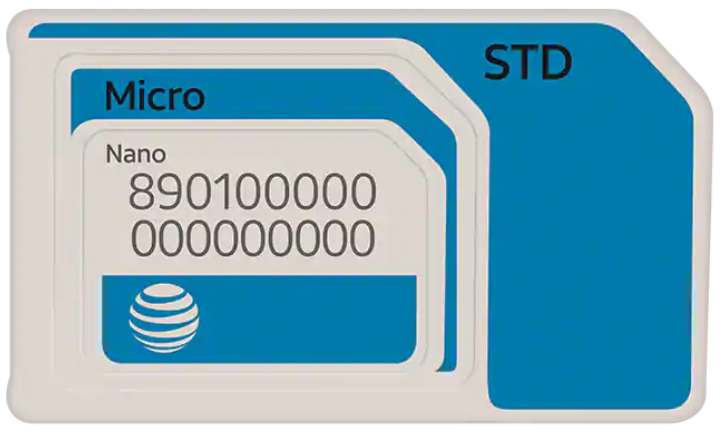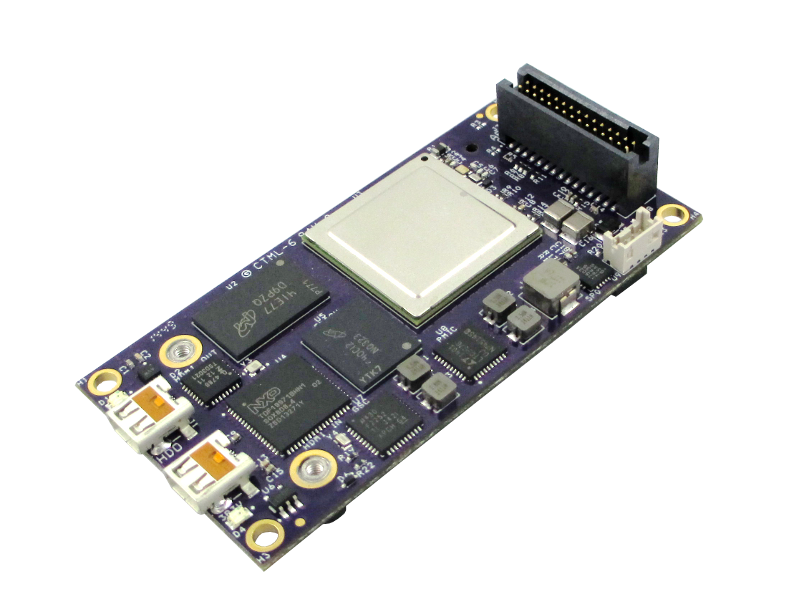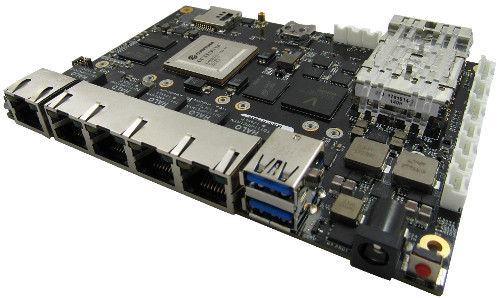
Embedded single board computers (SBCs), such as the Gateworks family of Industrial Single Board Computers, are used in many rugged and industrial remote applications throughout the world. Most applications typically communicate back to the cloud (internet) for various reasons, whether to download or upload data. Some installations are in remote locations without standard WiFi or Ethernet internet connectivity. Using a cellular modem is able to provide internet connectivity. Cellular connectivity is most well known through personal cell phones, but cellular modems are also offered in modules that will plug into a single board computer. There are many things to consider when selecting a cellular modem for Internet of Things (IoT) applications. These factors that are discussed below include modem speed, form factor, pin compatibility, cellular providers and certification.
1. Selecting a Modem Speed / Bandwidth

Cellular modems come in many different speed ratings. This is important based on the industrial application that the single board computer is going into. Some embedded applications pass very small amounts of data (such as temperature or GPS coordinates) while others are streaming video. It is important to fit the modem speed to the data requirements.
Modem speeds are rated by ‘Category’. The higher the category, the faster the speed. For example, a category 4 (CAT4) modem is slower than a category 11 (CAT11). There are newer modems designed for industrial sensor applications that are even slower than a CAT1. This lower speed is called a CATM1. There are also generations of mobile network technologies, such as 4th generation (4G) LTE and the newer 5th generation which is called 5G. The newer 5G standard is still very new and most modems are hard to source. The following 5G modems are those that have been identified so far: Telit FN990 (recommended), Quectel RM500Q, Sierra Wireless EM9190, SIMCOM SIM8200G-M2, and Fibocom FM150. Note 5G claims to reduce latency by 10x and increase bandwidth by 10x however there are three flavors of 5G that run at different frequencies, low band, mid band and high band (sometimes also called ultra-wide band or millimeter-wave) and each of these bands has different speed and range characteristics. For the highest performance, a high band modem is required but note the higher frequency also limits range and isn’t supported in many geographical locations at this time.
By matching the speed to the application, money can be saved. A low bandwidth, several Megabytes a month data plan will cost significantly less (a couple dollars a month) than an unlimited streaming data plan (30 to 200 dollars a month). In addition to the data plan, the modem itself will vary in price. Newer 5G high speed modems are on the order of 3-4 times more expensive then standard speed modems.
Power is also a crucial factor related to speed. CATM1 modems draw significantly less power than a high speed CAT11 or 5G modem. This can be important in remote embedded applications where the single board computer may be running off of a battery or solar power. Power also translates into heat, so faster modems will require a larger or more complex thermal solution and cooling.
2. Selecting a Modem Form Factor

The Gateworks Single Board Computers use Mini-PCIe slots as a standard interface for accessories such as WiFi and cellular modems. There are many modems that come in the Mini-PCIe form factor, however many of the newer modems use the smaller M.2 form factor. To support this smaller form factor, Gateworks has created a simple Mini-PCIe to M.2 adapter called the GW16140.
M.2 is complex because it has various pin key schemes as well as sizes. The most typical M.2 key used for modems is the B key. The B Key M.2 scheme includes all the necessary signals for modems, such as USB 2.0 and 3.0 as well as PCIe. M.2 also has various sizes, with the most common modem sizes being 3042 and 3052 (The first number is the width of the card in millimeters, the second number is the length in millimeters. So a 3042 size is 30mm wide and 42mm long). Unfortunately many companies have violated the M.2 length specification and thus Gateworks has made the GW16140 Mini-PCIe to M.2 adapter flexible to accommodate some of the non-standard lengths.
3. Examining Hardware Pin Compatibility

Gateworks strictly follows the official Mini-PCIe specification from PCI-SIG. This specification calls out for specific pin signals and voltages. The entire specification is sufficient for modem operation. Unfortunately, some modem manufacturers do not strictly adhere to the Mini-PCIe specification which causes pin conflicts which can lead to the modem not functioning correctly. Gateworks has worked to identify these conflicts and has found that many of them are common across the various manufacturers. Typical pin conflicts have been identified on the Gateworks Cellular Modem Wiki Page. There are many different methods to handle these conflicts as outlined below.
For development, it is possible to use some Kapton tape to mask the conflicting pins on the Mini-PCIe card. This often is cumbersome and purely for a proof of concept, to verify exactly which pins need to be blocked / disconnected and validate proper modem operation. Once the exact conflicts are identified, more long term methods can be used, as outlined below.
Gateworks produces adapters that essentially disconnect the most common conflicted pins. The GW16140 Mini-PCIe to M.2 adapter as an example only routes the USB signals from the Mini-PCIe slot up to the M.2 slot. The typical conflicting signals are not routed. The GW16103 Mini-PCIe adapter simply adds a SIM card for Mini-PCIe slots and modems that don’t have already attached SIM slots. The GW16103 by default passes all signals through, including typical conflicting signals, but they can be blocked by purchasing a special version in which inline resistors are removed.
On many of the Gateworks Single Board Computers, there are zero ohm resistors in the signal paths for the conflicted signals. By removing these resistors, the conflicts can be resolved. It is common for Gateworks to remove these resistors for customers who create a Gateworks Customer Special for large volume orders.
4. Selecting a Cellular SIM & Provider

There are many cellular providers throughout the world. Different providers offer different plans, pricing and features. Some providers have plans catering to the Internet of Things (IoT) market, which focuses on a high number of deployments with very low data usage. Each provider has their own version of certification (more in the certification section below) that is required to become a device on their network.
Gateworks headquarters are in the USA. The most common cellular providers in the USA are Verizon, AT&T, T-Mobile and Sprint. Verizon is known for a strong network while AT&T is known for a more lenient network. In Europe, Vodafone and Orange are common providers.
SIM Cards are required for a connection to the network as a way for the provider to control their provisioning and connections. SIMs are typically available direct from the cellular provider, but there are some companies that service multiple providers and sometimes even operate on a global scale. An example would be Hologram.io.
The size of the SIM will vary depending on the modem or adapter being used. The GW16140 M.2 adapter uses a Nano-SIM and can support two SIMs. Dual SIMs are supported on newer 5G modems to allow switching between networks if one network doesn’t have good signal strength. Most Gateworks boards contain a SIM socket mapped to one of the Mini-PCIe connectors to allow for quick cellular modem integration. For Mini-PCIe sites that don’t have a SIM, an adapter can be used to provide SIM support.
5. Certification
When building a solution with an industrial single board computer and cellular modem, there are several certifications that must be acquired.
- FCC Certification
- PTCRB Certification
- Carrier Certification

The first and most generic certification would be FCC certification. FCC is more generic and focuses on power and emissions through the USA government. Modems themselves have FCC approval, but the entire solution (SBC, enclosure, power supply, antennas) must also go through FCC certification. Gateworks has designed its SBCs to pass FCC certification, as explained on the Gateworks FCC Wiki Page. To find a test laboratory for FCC Certification, use the search tool on the FCC Website.

A PTCRB certification is common in North American. PTCRB is the standard review board that certifies devices to work on cellular networks. The requirements typically focus on emission compliance and SIM operation. There are modules and modems that are already PTCRB certified, which greatly reduce the final certification effort. For example, the Gateworks GW16132 CATM1 Mini-PCIe modem is pre-certified which will lead to a faster time to market. Other modems may also be pre-certified. To see a complete list of PTCRB certified devices, visit https://www.ptcrb.com/certified-devices/ Gateworks discusses more about PTCRB certification on the Gateworks Cellular Modem Wiki Page.
Lastly, the cellular provider will require certification. Certification is required so that the providers know more about the different devices that connect to their networks. Consumers are fortunate because the handset manufacturers (Apple, Samsung) go through this certification with many different providers, but when building a solution, this certification still needs to be done.It is fortunate that some cellular modem manufacturers will pre-certify their modems with some of the most common providers. This does not mean that the product can be used immediately, but rather helps shortcut the final certification process. The entire solution need to be carrier approved.
Summary
Cellular modems have a place in rugged and industrial embedded applications where an easy internet connection is required. There are many factors to consider when selecting a cellular modem for a solution. Different factors have different priorities for different applications. Some may require a high bandwidth. Others may only upload a couple of bytes per day and are very cost sensitive. Different providers offer different advantages. Certification and pin conflicts are areas to study carefully. Gateworks is available to provide advice and help accelerate to market a cellular solution utilizing a Gateworks SBC.
Gateworks Corporation designs and manufactures ARM based single board computers and cellular modem cards in the USA. Several industrial SBC families have varying sizes from 35x70mm up to 140x100mm with Mini-PCIe and M.2 slots specific for modem usage. The SBCs feature multiple ethernet (including dual Gigabit) ports as well as multiple Mini-PCIe slots for WiFi and Cellular radios. Each single board computer is designed with an optimized and highly efficient power supply that accepts 10-60VDC. To further view the entire line of Gateworks SBCs, please visit the Gateworks Industrial Single Board Computer product page.


